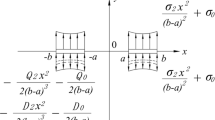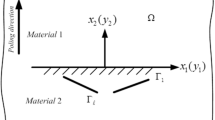Abstract
The Schmidt method is adopted to investigate the fracture problem of multiple parallel symmetric and permeable finite length mode-III cracks in a functionally graded piezoelectric/piezomagnetic material plane. This problem is formulated into dual integral equations, in which the unknown variables are the displacement jumps across the crack surfaces. In order to obtain the dual integral equations, the displacement jumps across the crack surfaces are directly expanded as a series of Jacobi polynomials. The results show that the stress, the electric displacement, and the magnetic flux intensity factors of cracks depend on the crack length, the functionally graded parameter, and the distance among the multiple parallel cracks. The crack shielding effect is also obviously presented in a functionally graded piezoelectric/piezomagnetic material plane with multiple parallel symmetric mode-III cracks.
Similar content being viewed by others
References
Spyropoulos, C. P., Sih, G. C., and Song, Z. F. Magneto-elastro-elastic composite with poling parallel to plane of line crack under out-of-plane deformation. Theoretical and Applied Fracture Mechanics, 39, 281–289 (2003)
Wang, B. L. and Mai, Y. W. Crack tip field in piezoelectric/piezomagnetic media. European Journal of Mechanics-A/Solid, 22, 591–602 (2003)
Gao, C. F., Kessler, H., and Balke, H. Crack problems in magneto-electro-elastic solids, part I: exact solution of a crack. International Journal of Engineering Science, 41, 969–981 (2003)
Liu, J. X., Liu, X. L., and Zhao, Y. B. Green’s functions for anisotropic magneto-electro-elastic solids with an elliptical cavity or a crack. International Journal of Engineering Science, 39, 1405–1418 (2001)
Chung, M. Y. and Ting, T. C. T. The Green function for a piezoelectric piezomagnetic anisotropic elastic medium with an elliptic hole or rigid inclusion. Philosophical Magazine Letters, 72, 405–410 (1995)
Pan, E. Three-dimensional Green’s functions in anisotropic magneto-electro-elastic bimaterials. Zeitschrift fur Angewandte Mathematik und Physik, 53, 815–838 (2002)
Gao, C. F., Kessler, H., and Balke, H. Fracture analysis of electromagnetic thermoelastic solids. European Journal of Mechanics-A/Solid, 22, 433–442 (2003)
Wang, B. L. and Mai, Y. W. Fracture of piezoelectromagnetic materials. Mechanics Research Communications, 31, 65–73 (2004)
Chen, W. Q., Lee, K. Y., and Ding, H. J. General solution for transversely isotropic magnetoelectro-thermo-elasticity and the potential theory method. International Journal of Engineering Science, 42, 1361–1379 (2004)
Wang, X. and Shen, Y. P. The general solution of three-dimensional problems in magneto-electroelastic media. International Journal of Engineering Science, 40, 1069–1080 (2002)
Van Suchtelen, J. Product properties: a new application of composite materials. Phillips Research Reports, 27, 28–37 (1972)
Wu, T. L. and Huang, J. H. Closed-form solutions for the magneto-electric coupling coefficients in fibrous composites with piezoelectric and piezomagnetic phases. International Journal of Solids and Structures, 37, 2981–3009 (2000)
Harshe, G., Dougherty, J. P., and Newnham, R. E. Theoretical modeling of 3-0/0-3 magnetoelectric composites. International Journal of Applied Electromagnetics in Materials, 4, 161–171 (1993)
Avellaneda, M. and Harshe, G. Magnetoelectric effect in piezoelectric/magnetostrictive multiplayer (2-2) composites. Journal of Intelligent Material Systems and Structures, 5, 501–513 (1994)
Benveniste, Y. Magnetoelectric effect in fibrous composites with piezoelectric and magnetostrictive phases. Physical Review B, 51(10), 16424–16427 (1995)
Huang, J. H. and Kuo, W. S. The analysis of piezoelectric/piezomagnetic composite materials containing ellipsoidal inclusions. Journal of Applied Physics, 81, 1378–1386 (1997)
Li, J. Y. Magneto-electro-elastic multi-inclusion and inhomogeneity problems and their applications in composite materials. International Journal of Engineering Science, 38, 1993–2011 (2000)
Nan, C. W. Magnetoelectric effect in composites of piezoelectric and piezomagnetic phases. Physical Review B, 50, 6082–6088 (1994)
Morse, P. M. and Feshbach, H. Methods of Theoretical Physics, Vol. 1, McGraw-Hill, New York (1958)
Zhou, Z. G., Wu, L. Z., and Wang, B. The dynamic behavior of two collinear interface cracks in magneto-electro-elastic composites. European Journal of Mechanics-A/Solids, 24, 253–262 (2005)
Zhou, Z. G., Zhang, P. W., and Wu, L. Z. The closed form solution of a Mode-I crack in the piezoelectric/piezomagnetic materials. International Journal of Solids and Structures, 44, 419–435 (2007)
Takagi, K., Li, J. F., Yokoyama, S., and Watanabe, R. Fabrication and evaluation of PZT/Pt piezoelectric composites and functionally graded actuators. Journal of the European Ceramic Society, 10, 1577–1583 (2003)
Jin, D. R. Functionally graded PZT/ZnO piezoelectric composites. Journal of Materials Science Letters, 22, 971–974 (2003)
Li, C. Y. and Weng, G. J. Antiplane crack problem in functionally graded piezoelectric materials. Journal of Applied Mechanics, 69, 481–488 (2002)
Zhou, Z. G. and Wang, B. Two parallel symmetry permeable cracks in functionally graded piezoelectric/piezomagnetic materials under anti-plane shear loading. International Journal of Solids and Structures, 41, 4407–4422 (2004)
Fang, X. Q., Liu, J. X., and Wang, D. B. Dynamic stress from a subsurface cavity in a semi-infinite functionally graded piezoelectric/piezomagnetic material. Applied Mathematical Modelling, 34, 2789–2805 (2010)
Wang, X. H., Fang, X. Q., and Liu, J. X. Dynamic stress from a circular hole in a functionally graded piezoelectric/piezomagnetic material subjected to shear waves. Philosophical Magnazine, 89, 3059–3074 (2009)
Zhou, Z. G. and Chen, Z. T. Basic solution of a mode-I limited-permeable crack in functionally graded piezoelectric/piezomagnetic materials. International Journal of Solids and Structures, 45, 2265–2296 (2008)
Guo, L. F., Li, X., and Ding, S. H. Crack in a bonded functionally graded magneto-electro-elastic strip. Computational Materials Science, 46, 452–458 (2009)
Zhang, P. W., Zhou, Z. G., and Wang, B. The dynamic behavior of two collinear interface cracks between two dissimiliar functionally graded piezoelectric/piezomagnetic material strip. Applied Mathematics and Mechanics (English Edition), 28(5), 615–625 (2007) doi: 10.1007/s10486-007-0507-1
Tong, Z. H., Jiang, C. P., Lo, S. H., and Cheung, Y. K. A closed form solution to the antiplane problem of doubly periodic cracks of unequal size in piezoelectric materials. Mechanics of Materials, 38, 269–286 (2006)
Chen, J. and Liu, Z. X. On the dynamic behavior of a functionally graded piezoelectric strip with periodic cracks vertical to the boundary. International Journal of Solids and Structures, 42, 3133–3146 (2005)
Wang, B. L. and Han, J. C. Multiple cracking of magnetoelectroelastic materials in coupling thermo-electro-magneto-mechanical loading environments. Computational Materials Science, 39, 291–304 (2007)
Han, J. J. and Chen, Y. H. Multiple parallel cracks interaction problem in piezoelectric ceramics. International Journal of Solids and Structures, 36, 3375–3390 (1999)
Tian, W. Y. and Gabbert, U. Multiple crack interaction problem in magnetoelectroelastic solids. European Journal of Mechanics-A/Solid, 23, 599–614 (2004)
Zhou, Z. G., Zhang, P. W., and Li, G. Q. Interactions of multiple parallel symmetric permeable mode-III cracks in a piezoelectric material plane. European Journal of Mechanics-A/Solids, 28, 728–737 (2009)
Soh, A. K., Fang, D. N., and Lee, K. L. Analysis of a bi-piezoelectric ceramic layer with an interfacial crack subjected to anti-plane shear and in-plane electric loading. European Journal of Mechanics-A/Solid, 19, 961–977 (2000)
Delale, F. and Erdogan, F. On the mechanical modeling of the interfacial region in bonded halfplanes. ASME Journal of Applied Mechanics, 55, 317–324 (1998)
Guo, L. C. and Noda, N. Modeling method for a crack problem of functionally graded materials with arbitrary properties-piecewise-exponential model. International Journal of Solids Structrues, 44, 6768–6790 (2007)
Gradshteyn, I. S. and Ryzhik, I. M. Table of Integral, Series and Products, Academic Press, New York,1035–1037 (1980)
Erdelyi, A. Tables of Integral Transforms, Vol. 1, McGraw-Hill, New York, 34–89 (1954)
Ratwani, M. and Gupta, G. D. Interaction between parallel cracks in layered composites. International Journal of Solids and Structures, 10, 701–708 (1974)
Shbeeb, N. I. and Binienda, W. K. Analysis of an interface crack for a functionally graded strip sandwiched between two homogeneous layers of finite thickness. Engineering Fracture Mechanics, 64, 693–720 (1999)
Author information
Authors and Affiliations
Corresponding author
Additional information
Project supported by the National Natural Science Foundation of China (Nos. 11002041 and 11272105), the Key Laboratory Opening Funding of Advanced Composites in Special Environment (No.HIT.KLOF.2009032), and the Research Fund for the Doctoral Program of Higher Education of China (No. 20092302110006)
Rights and permissions
About this article
Cite this article
Pan, Sd., Zhou, Zg. & Wu, Lz. Basic solutions of multiple parallel symmetric mode-III cracks in functionally graded piezoelectric/piezomagnetic material plane. Appl. Math. Mech.-Engl. Ed. 34, 1201–1224 (2013). https://doi.org/10.1007/s10483-013-1739-6
Received:
Revised:
Published:
Issue Date:
DOI: https://doi.org/10.1007/s10483-013-1739-6
Key words
- functionally graded piezoelectric/piezomagnetic material
- multiple parallel symmetric crack
- crack shielding effect
- solid mechanics




